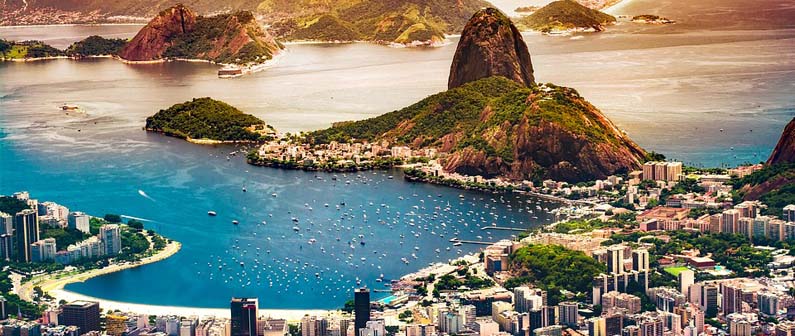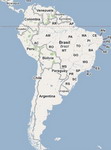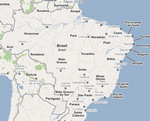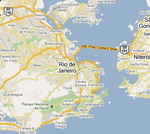A Guide To Rio De Janeiro
by James Burrows
Browse
accommodation options in Rio de Janeiro
The Marvelous City (Cidade
Maravilhosa), Rio De Janeiro is a Southeast Brazilian city on Guanabara
Bay, an arm of the Atlantic Ocean. The city was founded by Portuguese in
the 16th Century.
According to a tradition
belief, the city was named “Rio de Janeiro” meaning “River of January”
by the Portuguese explorers in 1502 believing Guanabara Bay to be the mouth
of a river. The city of Rio de Janeiro became the capital of the colony
of Brazil in 1763, the capital of the Brazilian empire in 1822, and the
capital of the independent Brazil in 1889; however the capital was shifted
to Brasília in 1960.

The former capital of Brazil,
Rio De Janeiro City acquired its modern cloak in the early 1900s. Rio De
Janeiro city is presently the second largest city after São Paulo,
and the capital of Rio de Janeiro State of Brazil. It is the cultural,
financial, commercial, communication, and transportation hub of Brazil.
The city is commonly known as Rio, particularly in English and Brazilians.
The official song of Rio is "Cidade Maravilhosa."
The estimated population
of the city in 2005 is about 6,094,183. The residents of the city are known
as Cariocas. The majority of the population of the city is of Portuguese
descent. It includes a large number of people of African descent, and mulattos
of mixed Portuguese and African descent. The city’s other important ethnic
groups include Germans, Italians, Spaniards, Arabs, Jews, Asians (mostly
Koreans and Japanese), and mixed Amerindians. Percentage wise, the population
is comprised of White European descent (56%), of mixed-race descent (32.3%),
of Black African descent (11.4%), of Asian descent (0.1%) and of Amerindian
descent (0.1%).
The only Portuguese-speaking
nation in the Americas is Brazil. In fact Portuguese is the official language
that is spoken by almost the entire population. It’s the language largely
used in schools, newspapers, radio, TV and for all business and administrative
purposes. The Portuguese language in Brazil has undergone fewer phonetic
changes that often called the “language of Camões.” The other languages
spoken in the city and the entire Brazil include English, Spanish, Brazilian
German dialects, such as Riograndenser Hunsrückisch and the Pomeranian
language, and also the Talian, based on the Italian Venetian language,
and Japanese In the city of São Paulo.
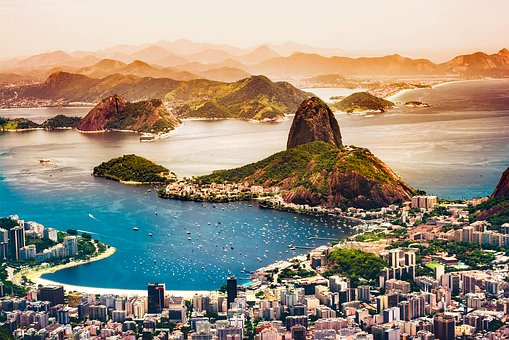
Rio is largely divided into
Centro, Zona Sul (South Zone), Zona Norte (North Zone), and Zona Oeste
(West Zone). The “Centro” is comprised of the historic downtown. Including
Santa Teresa, the “Centro” is the city's financial and business center.
The Zona Sul (South Zone) is the tourist-friendly area with the world-famous
beaches. The Zone including the Copacabana and Ipanema is the epicenter
of the city's tourist activity.
The Zona Norte (North Zone)
is the industrial zone, and is home to the Maracanã stadium, which
was once the world's highest capacity football (soccer) venue. The Zona
Oeste (West Zone) is a suburban area including primarily the districts
of Jacarepaguá, and Barra da Tijuca, popular for its beaches.
Situated in the tropical
South Atlantic, Rio is warm all year round. The summers (November to March)
are very hot and humid. The winters (June to September) are cool and dry,
never cold, with some precipitation. Rio is one of the popular tourist
destinations of the world. Hemmed in beautiful low mountain ranges, Rio
De Janeiro is one of the most beautiful natural harbors of the world.
The city is known for its
breathtaking landscape, its laidback beach culture and its annual carnival.
Highly celebrated city of Brazil, Rio is widely known for its scenic beauty,
natural setting, Carnival celebrations, samba and other music, and marvelous
crescent-shaped beaches, such as Copacabana, Ipanema, and Leblon. Rio is
known for being easy-going and friendly lifestyle.

Samba music and samba dance
is soul of Rio and Brazil. It’s the essence of the Rio carnival- Brazilian
Carnival that is an annual celebration held 40 days before Easter, marking
the start of Lent. The carnival in Rio de Janeiro features a number of
parades including the famous Escolas de Samba (Samba schools) parades in
the sambódromo exhibition centre; the popular 'blocos de carnaval'
that parades in almost every corner of the city; Cordão do Bola
Preta, one of the most traditional exhibits that parades in the centre
of the city; Suvaco do Cristo parades in the Botanic Garden; Carmelitas
parades in the hills of Santa Teresa; Simpatia é Quase Amor parades
in Ipanema; and Banda de Ipanema including families and a wide spectrum
of the gay population that parades in Ipanema.
Rio is the city full of a
number of terrific tourist attractions. The city is blessed with numerous
spectacular sights, beautiful beaches, elegant edifices, magnificent museums,
and pleasing parks.
Spectacular sights include
Corcovado, Pão de Açúcar, Lagoa Rodrigo de Freitas,
The Maracanã stadium, Parque Lage, and Jardim Botanico. The beautiful
beaches in city include Flamengo, Botafogo, Leme, Copacabana, Arpoador,
Ipanema, Leblon, Recreio dos Bandeirantes, and Grumari. Copacabana and
Ipanema are the hot favorites of tourists.
Elegant Edifices in the city
include Paço Imperial (1743, old Imperial Palace in downtown, next
to Praça XV, Fifteen Square), Casa França Brasil (1820, French
cultural center in downtown, next to CCBB), CCBB - Centro Cultural Banco
do Brasil (1906, a cultural center with gallery, movie theater in downtown),
Candelária Church (neoclassic cathedral next to CCBB), Mosteiro
de São Bento (1663, Saint Benedict's Monastery, colonial architecture
in downtown), Ilha Fiscal Palace (1889- in the Guanabara Bay, next to the
Navy Museum), Palácio Gustavo Capanema ( A modern architecture in
downtown designed by French architect Le Corbusier), Arcos da Lapa (1750),
Catedral Metropolitana (cone-shaped cathedral in Lapa), São Francisco
da Penitência church (1773 - colonial church), Theatro Municipal
(1909 - City Theater in Cinelândia square), Biblioteca Nacional (1910
- National Library in Cinelândia square), Câmara Municipal
(City Hall in Cinelândia square), Palácio do Catete (the former
presidential palace (1893-1960), now a museum of recent history), Itamaraty
(the former presidential palace), and Palácio Guanabara (Former
palace of the Imperial Princess)Magnificent Museums of the city include
Centro Museums, Zona Sul (South Zone) Museums, Zona Norte (North Zone)
Museums, and Zona Oeste (West Zone) Museums.
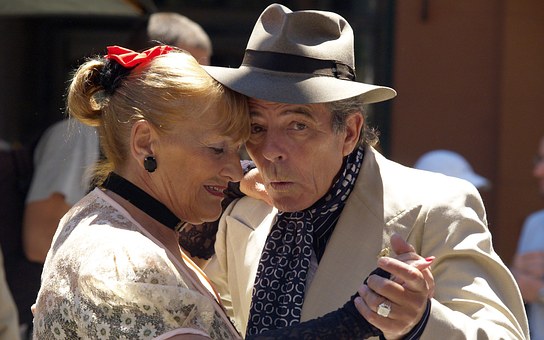
The Centro Museums include
Museu Histórico Nacional (National Museum of History, Downtown),
Museu Nacional de Belas Artes (Museum of Fine Arts, Downtown), MAM - Museu
de Arte Moderna (Museum of Modern Art, Downtown), Museu da Imagem e do
Som (Image and Sound Museum, Downtown), Museu Naval (Navy Museum, Downtown),
Museu do Carnaval (Museum of Carnival, Downtown), and Museu Chácara
do Céu (Museum of South American modern art, Downtown). Zona Sul
(South Zone) Museums include Jardim Botânico (Botanical Garden),
Museu da República (Museum of the Republic), Centro Cultural Telemar
(Telemar Cultural Center), Museu Internacional de Arte Naïf (International
Naïf Art Museum), Museu Carmem Miranda (Carmem Miranda Museum), Museu
do Índio (Museum of the Indian), and Museu Villa-Lobos (Museum of
Brazil's most important composer).
Zona Norte (North Zone) Museums
include Museu Nacional (National Museum), Museu do Primeiro Reinado (First
Reign Museum), Museu Museu de Astronomia e Ciências Afins (Astronomy
Museum), Museu do Trem (Train Museum), and Museu Aeroespacial (Aerospatial
Museum).
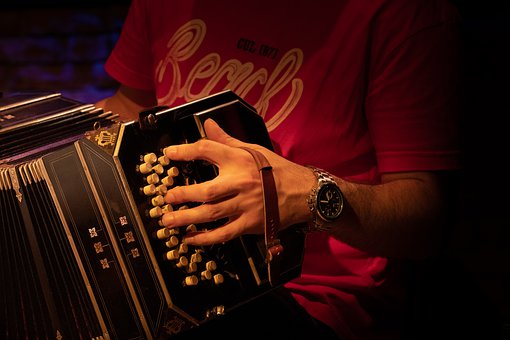
The only museum in Zona Oeste
(West Zone) is Museu Casa do Pontal that is the most important collection
of popular craft and artisanin Recreio dos Bandeirantes.
The Pleasing Parks in the
city include Jardim Botânico, Parque Lage, Parque do Flamengo, Parque
Guinle, Campo de Santana, and Quinta da Boa Vista.
Rio is one of the major transportation
hubs of Brazil, situated 450 km (280 mi) from Belo Horizonte, and 430 km
(270 mi) from Sao Paulo. Located 20 km away from the city center
and main hotels, the Galeão - Antônio Carlos Jobim International
Airport (Galeão International Airport) is the major international
airport of Rio de Janeiro receiving most of the International and domestic
flights. Santos Dumont Airport, located right in the city center, by the
Guanabara Bay, receives flights from Sao Paulo and a few other domestic
destinations.
Browse
accommodation options in Rio de Janeiro
top
|
Eat
and drink in Rio de Janeiro by Angela Corrias
Browse
accommodation options in Rio de Janeiro
I have been to Rio de Janeiro
maybe five times and what amazes me the most, after the greatest opportunity
to meet people from all walks of life, is the great choice of restaurants
and different kinds of food. My last visit to one of the most spectacular
cities in the world was last July and exactly like every time, I spent
my way back to Europe thinking that, sooner or later, I will go to live
there.
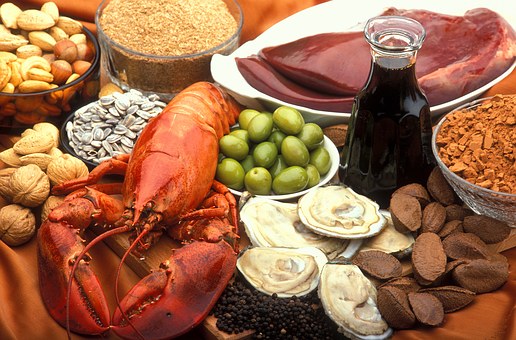
With deep trust on indigenous,
I started asking everybody where I could find a good place to eat and every
time the answer was a prompt: at Marius of course! Curious by such enthusiasm
I decided to give the so-called top restaurant of the city a try. Beautifully
set in front of Leme Beach, adjoining to the worldwide famous Copacabana,
it’s by no means the run-of-the-mill example of a five-star restaurant.
As soon as you reach the
longed spot after a battle in Rio’s traffic, you’ll find yourself facing
the first hard choice of your adventure: fish or meat? In fact, apparently
for the endless variety in the menu, there are two versions of the same
restaurant, one beside the other. In a typical Brazilian style, your journey
will start with a never-ending buffet with all sort of appetizers, starters
and dishes. While you are enjoying the best “Farofa” you have ever had,
charming waiters will succeed each other with traditional and brand new
choice of spit-roasted churrasco in the “meat-version” of the restaurant.

If, instead, you’ve chosen
fish, after tackling a swordfish-based ‘muqueca’ and a ‘catupiri’ with
small, delicious prawns, I feel compelled to mention the toilets: they
definitely are worth a visit. Ground and sinks filled with mock-precious
stones, characteristic fish-shaped taps and heady incense perfume.
Miles far away from the classic
conception of restaurant, Marius is the latest generation of luxurious
holiday destinations. But Rio de Janeiro offers an impressive range of
restaurants, for every taste, pocket and style. One of my favourite lunches
is in the typical "Galletos" places that you can easily find all over the
city.
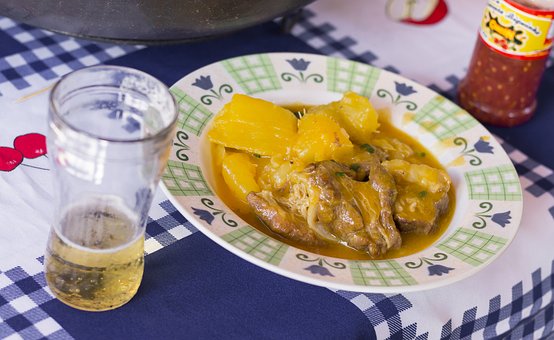
The last one I visited is
in Ipanema, precisely in Rua Visconde de Pirajà. It's in a corner
and in its simple façade a big menu is shown. Basically, you will
have half chicken well spit-roasted and a consistent side course at your
choice. The choice is various and colourful, where we can match the chicken
with farofa, rice, beans, salad and so on. My drink is of course Guaranà.
The price is around eight reals per person, which means around three euro
for a portion I had hard time to finish. I go very often to Brazil and
its galletos are for sure on my to-do-list. From luxurious restaurants
to simple bistros, from genuine ‘lanchonetes’ to ‘coconut stands’, all
over the city the possibilities to get refreshed are countless and everywhere
the warmth of brazilian weather and people will make you feel at home.
Browse
accommodation options in Rio de Janeiro
top
|

